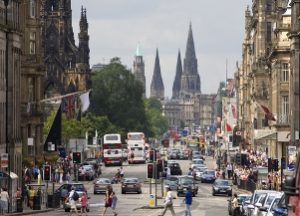Edinburgh defends air quality benefits of 20mph roads
City councillors approve a map of proposed new speed limits for the Scottish capital, to come into effect from late 2015
Edinburgh city council insists plans it has approved today (January 13) to introduce 20mph speed limits on the majority of residential streets in the capital will not worsen air quality as “vehicles flow more smoothly through junctions at slower speeds”.
Councillors today agreed to a map of city speed limits which would see 20mph speed limit imposed on residential and shopping streets with a network of 30mph and 40mph limits maintained for key arterial routes, making the Scottish capital the ‘first 20mph city in Scotland’.
Subject to securing necessary Speed Limit Orders, these new arrangements would come into effect on a phased basis from late 2015 onwards, with the aim of increasing road safety and encouraging more people to travel by foot or bicycle in the city, with resulting indirect benefits for air quality.
However, the proposals have faced some confusion and opposition from residents over the extent, enforcement and environmental benefits of lower speed limits, and the council has today sent out a missive entitled ‘Top ten 20mph myths — busted’ in response.
The council’s Local Transport Strategy 2014-2019, agreed last January, states that although recent research “does not suggest that there are any significant adverse impacts” on air quality, the effects on emissions of a change of limit from 30mph to 20mph “are uncertain”.
However, in its myth-busting list today, the council seeks to address concerns that lower speeds will worsen air quality in the city, stating that although research is not conclusive “some environmental benefit from the change is expected from helping to unlock the potential for walking or cycling short distances instead of driving”.
In addition, according to the council: “Research indicates vehicles flow more smoothly through junctions at slower speeds. Additionally, as a result of reduced acceleration and braking, 20mph may help to reduce fuel consumption and associated emissions.”
The council also insists that the limits will be enforced as they are on roads elsewhere by Police Scotland and will reduce traffic noise, improve health and safety as well as boosting local business and communities.
The speed limits changes follow the May 2014 launch of the controversial tram transport system in Edinburgh, which is expected to benefit air quality in the city after three million people used the service within the first six months of its launch. Local buses and park and ride schemes have also been attracting record numbers of travellers.
Misconceptions
Welcoming the approval of the map today, the city’s transport convener, councillor Lesley Hinds, said that the initiative had been under development for three years and that the most recent public consultation showed support for the proposals from 60% of respondents.

Graph showing NO2 levels at 13 monitoring sites in Scotland in 2014 (image: Friends of the Earth Scotland)
However, the proposals have faced opposition from some, and councillor Hinds also took the chance to address “misconceptions” among residents, stating: “There have been a number of claims flying about to do with the ins and outs of the 20mph rollout which are quite simply untrue and it’s vital that everyone has the full facts at their fingertips.”
She said: “For example, it’s not a ‘blanket rollout’ at all. Each street which is earmarked to become 20mph has been selected based on robust criteria agreed with key stakeholders, including bus companies and Police Scotland.”
She added: “It’s important that we get the balance right as much as we can, however inevitably not everyone will be able to get what they hoped for.”
A detailed implementation plan for the new speed limit proposals — including costings — will be now considered by the council’s transport and environment committee in March 2015.
Stuart Hay, Head of Living Streets Scotland, said: “Edinburgh’s 20mph limit policy sets a positive example for cities across Scotland and the UK. Lower speeds on shopping and residential streets means a safer and more pleasant city for everyone with higher levels of walking and lower levels of accidents.
“Living Streets looks forward to working with the council to promote the scheme and its benefits as it is rolled out.”
It follows the claims this week from Friends of the Earth that there was “little improvement” in air quality in Scotland in 2014, although the Scottish Government has promised to launch a draft Low Emissions Strategy for consultation before the end of the month (see airqualitynews.com story).







 Network
Network

